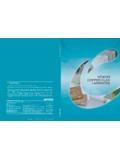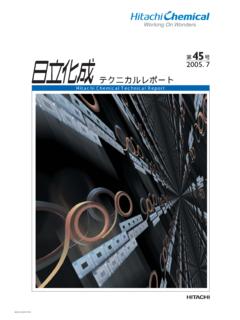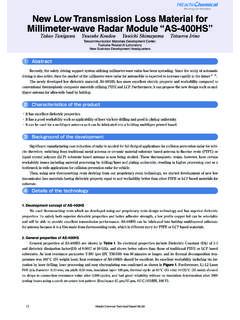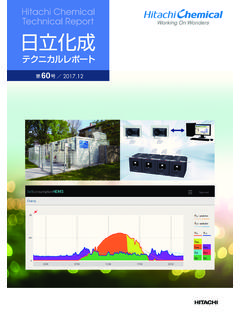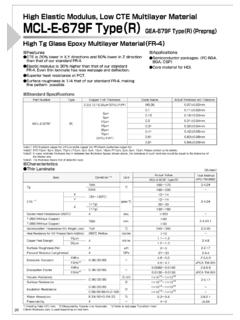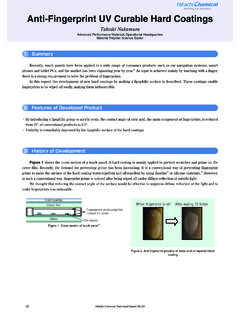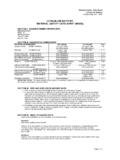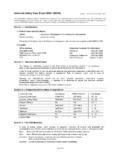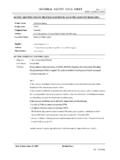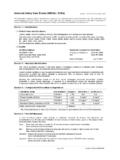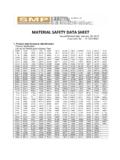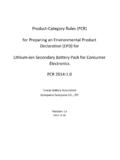Transcription of Lithium Ion Battery - hitachi-chem.co.jp
1 Hitachi Chemical Technical Report market of Lithium ion batter y (LIB) is growing year by year in small electronic equipment, cars and industrial applications, and the further expansion in future is expected. We have developed and commercialized the LIB related materials such as high-performance carbon cathode based on the technologies of various organic and inorganic materials. In October 2012, the development group of our Tsukuba Research Laborator y and the LIB equipment development group of Shin-Kobe Electric Machiner y Co., Ltd. were consolidated for the fusion of technologies of material and device. In this paper, our LIB and LIB material technology for industrial use is LIB market got under way with applications to consumer products represented by cellular phones and personal computers (PC), followed by cars and then industrial use. Currently however, LIB used in consumer electronics products must offer even higher energy density due to the emergence of new devices such as smartphones and tablet computers.
2 In response, silicon anode active material looks set to replace carbon anode active material for LIB. Moreover, technology1) to apply ceramic coating to the surface of a separator or electrode is being practically applied to further enhance the LIB field for car applications, car-grade batter y cells tailored for individual vehicles such as HEV and EV has been developed, the full-scale practical application of which is already under way. In response to the high LIB power output requirement for HEV, batter y cells with power density of 4500 W/kg have been developed. Various innovations are being attempted to reduce the internal resistance of a batter y. Since LIB for EV requires a high-energy output to extend driving distance, a batter y cell with power density of around 130 Wh/kg has been put into practical use. Technologies to control the batter y cell condition and cell temperature are also important because LIBs for car applications are used in batter y modules comprising many contrast, LIB for industrial use has now reached the stage of performing wide-range verification tests for output variation control for photovoltaic power generation system and wind power generators, back-up power supply while striving to reduce power consumption during peak demand at factories, buildings, etc.
3 , back-up power supply during power outages and par tly employed for practical use. Performance requirements for LIB for industrial use var y significantly depending on the intended applications but the extended ser vice life, high-level safety and reliability are common baseline performances, which development activity is thus continuing to case examples of LIB for industrial use, we introduce products and technologies developed/manufactured by our group company, Shin-Kobe Electric Machiner y Co., Ltd., in the Large-Capacity, High Output Power and Long Service Life: CH75 This batter y cell comprises a 75 Ah large-capacity cell that can be built into a large-scale electric energy storage system using relatively few cells with reliable performance and low operating cost. Even though CH75 is a large-capacity cell, it can maintain continuous discharge at 3 CA (225 A) and meet the required discharge current of a batter y for 30 minutes or less while reducing power consumption during peak demand at factories, etc.
4 Also CH75 can expect a ser vice life to endure up to 4,000 repeated charge-discharge cycles (25 C, at a 75% depth of discharge). To achieve such high output power and extended ser vice life, we employed a newly Mn-rich cathode active material, reduced the electrode and electrolyte resistance and stabilized the SEI layer formed on the anode its high-energy storage capacity, CH75 maintains a high level of safety and satisfies JIS (Japanese Industrial Standards) C8715-2, etc. Photos showing the external appearance of a cell and a module comprising 6 cells are shown in Figure Large-Capacity, Long Service Life, Float Charging: KL200 FKL200FL is a type of 210 Ah large-capacity float charging cell co-developed by Shin-Kobe Electric Machiner y Co., Ltd. and NTT FACILITIES, INC. KL200F is used in a batter y system to supply back-up power in emergencies for communication equipment and data centers.
5 The distinctive feature of the cell is a type using non-flammable electrolyte by replacing flammable organic electrolytes to achieve high-level safety as we anticipate numerous cells will be installed in data centers and other facilities Lithium Ion BatteryMasato Yoshida Tokiyoshi Hirasawa Keiji SumiyaNew Business Development HeadquartersTsukuba Research LaboratoryEnergy Devices and Materials Development CenterReview 1 Trend of the Lithium Ion Battery Market2 LIB for Industrial Use Hitachi Chemical Technical Report urban buildings. To make electrolyte non-flammable, phosphazene flame retardant is used in combination with a new electrolyte composition3). Also, an expected ser vice life of a decade or more has been achieved by improving the Mn cathode active material and employing the aforementioned new electrolyte composition4). Photos showing the external appearances of a batter y cell and a 48 V Batter y System for Back-up Power Supply using this cell are shown in Figure technologies developed for LIB for industrial use are introduced as mentioned above; as for LIB ser vice life for use in large-scale electric energy storage systems, a lifetime of 10 to 20 years, almost equivalent to installed facilities, is desired.
6 Hence, we are engaged in developing technologies to secure intrinsic safety and extended batter y life by using non-flammable electrolyte or non-combustible ionic market size of LIB for consumer products, cars and industrial use is expected to continue growing in future. The LIB market for cars in particular has been soaring in recent years, while the market size for industrial use is also expected to reach around billion yen annually. To maintain the expansion of the LIB market for cars, a huge breakthrough in terms of improving electric energy density and cost reduction is required. NEDO announced electric energy density of 250 Wh/kg and product cost of about 20 yen/kg as its development targets for 2020 or so. Furthermore, NEDO set an energy density of 500 Wh/kg and a product cost of about 10 yen/kg as targets for around 2030 in anticipation of the post-LIB the expansion of the LIB market for industrial use in our business domain is expected to trail the market growth of LIB for cars, we foresee that proven LIB technologies backed by experience in consumer products and car markets can be provided for industrial applications at lower cost.
7 Accordingly, we must be engaged in developing new LIB technologies for industrial use while constantly monitoring leading technologies. We must also validate various large-scale electric energy storage systems considered promising in a future energy plan, at an early stage and accumulate such technologies as required for practical , LIB usage varies significantly depending on the intended use, such as the output variation control for photovoltaic power generation systems, back-up power supply during reduced power consumption at factories during times of peak demand. Therefore we need buildings and proposals for optimum electric energy storage systems from a cost perspective and with long-term reliability in mind by adopting a per formance-sharing approach suppor ted by an LIB/lead-acid batter y hybrid energy storage system where LIB provides a quick charge/discharge rate and a lead-acid batter y one that is slow.
8 In addition to LIB improvements for industrial use, the development of technology offering optimum solutions established by combining our lead-acid batter y, Lithium ion capacitor and condenser is expected and will become increasingly important in was first commercialized in 1991 and its market size is expected to reach 1 trillion yen in 2020 thanks to soaring demand for compact mobile equipment such as mobile phones and PCs, the market for environmentally friendly HEVs and EVs and that for industrial applications prompted by the introduction of a renewable energy policy after the Great East Japan Ear thquake. Conversely, given the need for a breakthrough in batter y performance including even higher energy density, extended ser vice life, enhanced safety or further product cost reduction, the development of new technologies, including new batter y materials, is considered crucial. The major common challenges for us to develop main LIB materials are indicated in the following: Cathode material: Higher capacity, Improved electronic conductivity, Accommodation of a swift charge/discharge rate, and others Anode material: Higher capacity, Improved cycle life performance characteristics, and others Separator: Safety improvement (balancing heat resistance and shutdown mechanism), and others Electrolyte: Non-flammable, Non-combustible, Lithium ion conductivity, Permeability, and others Binder resin: Electrolyte resistance, High adhesion, and othersFigure 2 KL200FL Cell and 48 V Battery SystemFigure 1 CH75 Cell and Module3 Toward the Expanded Application of LIB in Future4 Overview of LIB Materials Hitachi Chemical Technical Report materials are under development to meet wide-ranging performance requirements with potential LIB applications and usages.
9 To date, we have been involved in R&D and production of mainly high-performance carbon anode LIB materials utilizing our material-related proprietar y technologies, including various synthetic technologies involving organic/inorganic materials and process technology. Here, we introduce LIB material and other material technologies which we have developed in-house as case Anode MaterialSince LIB was commercialized in 1991, there has been sustained demand for high-energy density and improvement of the high current property required in the high-performance environment. While carbon material remains the mainstream material, metal anode materials such as silicon (Si) and tin (Sn), which can stoichiometrically allow higher batter y capacity, and hybrid materials, have already been practically applied on a partial scale. However, some pending technical issues remain to be solved, including (charge/discharge) cycling characteristics, hence continued effort to boost the conventional performance of carbon anode materials7) is required.
10 Currently we are continuing efforts to develop and commercially produce graphite anode materials selected within our carbon anode material group, and supply them to our clients thanks to the advantageous feature of graphite anode material, where graphite anode material shows a rated capacity close to the theoretical capacity of graphite (372 Ah/Kg), a slight decrease in discharge capacity under high current discharge conditions, superior fast charge/discharge performance, a slight decrease in discharge capacity at high electrode density and the ability to materialize a higher-capacity batter y. In addition, in response to the needs for a next-generation material which can offer batter y capacity exceeding the theoretical value of carbon, we are in the process of validating the commercialization of next-generation metal anode material with more than twice the capacity of carbon and superior fast charge/discharge performance. We will continue this R&D activity toward commercialization of products to achieve even higher performance Binder ResinIn the resin binder field, a critical building block to construct electrodes, we newly developed solvent-based acr ylic binder resins with superior anti-swelling property, thanks to electrolytes and good adhesion9).
